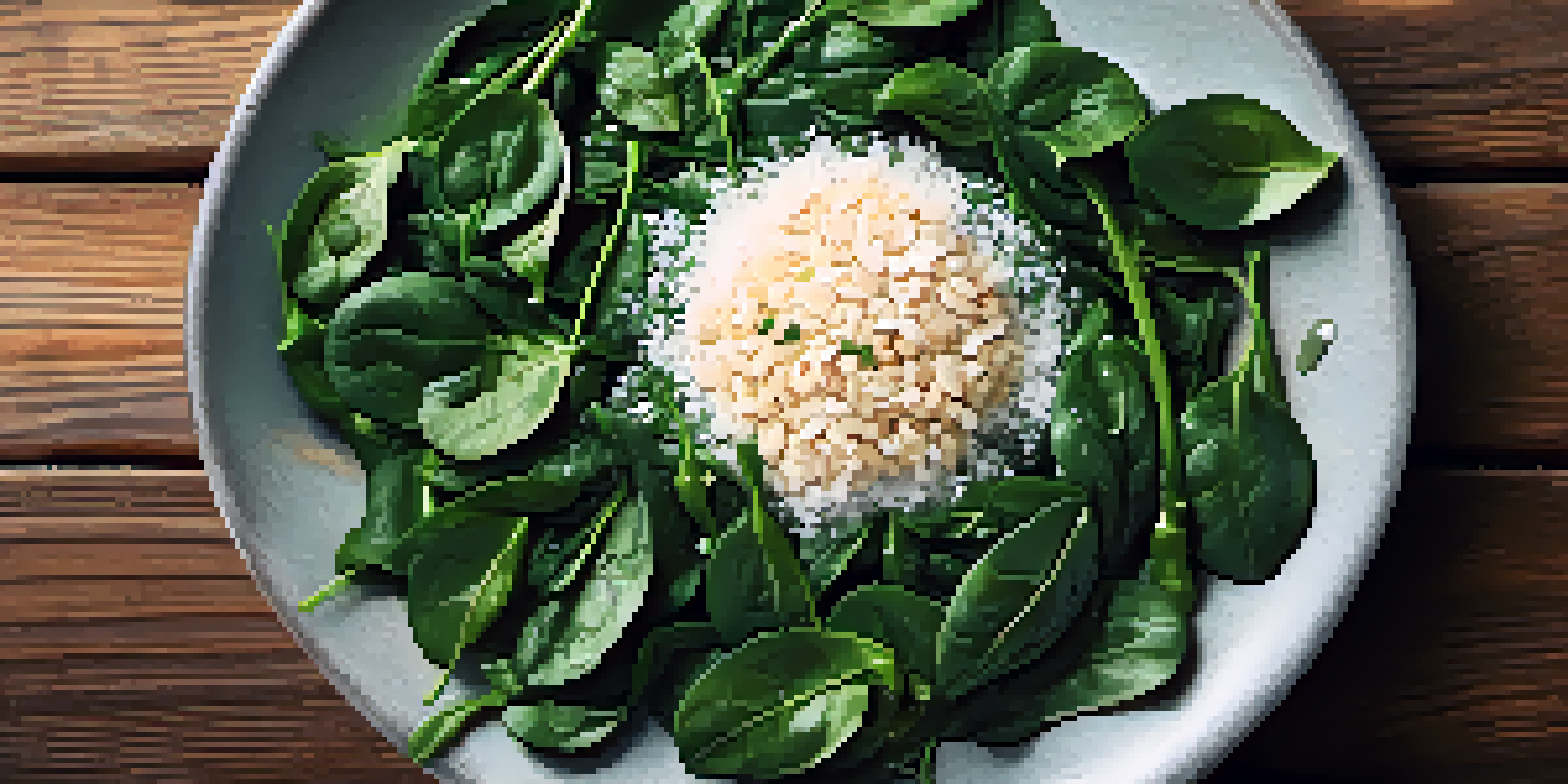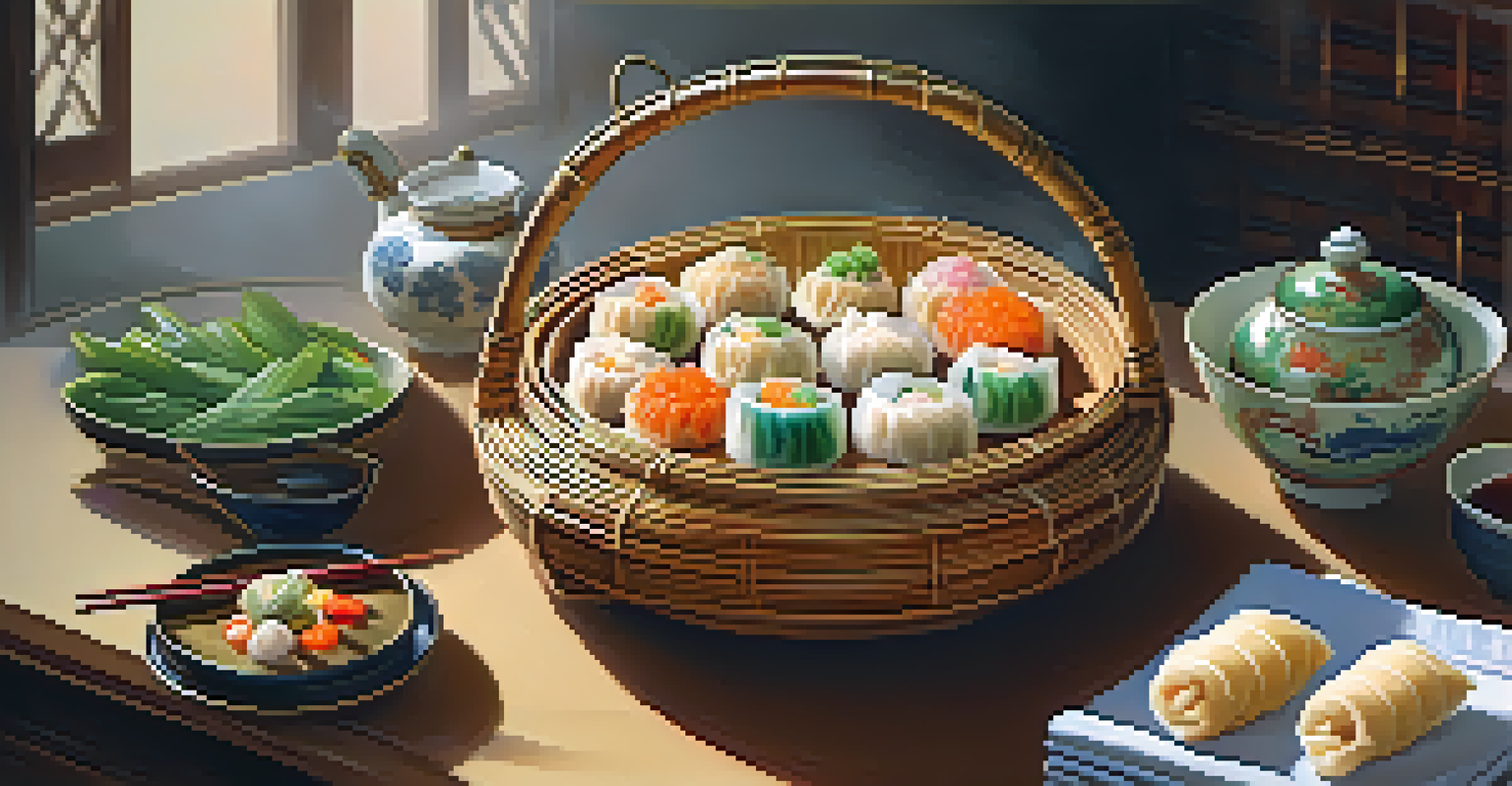Culinary Techniques from Around the World: A Global Perspective

The Art of Sautéing: A Quick and Flavorful Technique
Sautéing is a culinary technique that involves cooking food quickly in a small amount of oil or fat. This method is commonly used for vegetables and proteins, allowing them to retain their texture and flavor. For instance, a quick sauté of garlic and spinach can create a vibrant side dish in minutes, showcasing the freshness of the ingredients.
Cooking is like love. It should be entered into with abandon or not at all.
The key to successful sautéing lies in the heat: a hot pan helps to sear the food, locking in juices while preventing it from becoming soggy. This technique not only enhances the flavors but also preserves the nutrients in the ingredients. Imagine the delightful aroma wafting through your kitchen as you sauté your favorite veggies—it's a simple yet effective way to elevate your meals.
Moreover, sautéing can serve as the base for many dishes. Think of a classic stir-fry or a base for sauces; it’s versatile and can easily adapt to different cuisines. Whether you’re preparing a quick dinner or an elaborate feast, mastering sautéing can transform your culinary skills.
Steaming: A Healthy Cooking Method with Global Roots
Steaming is one of the oldest cooking techniques, utilized across various cultures for its health benefits. This method involves cooking food by placing it above boiling water, allowing steam to circulate and cook the food gently. For example, Chinese dim sum often features steamed dumplings, showcasing the technique’s ability to enhance flavors while keeping dishes light and nutritious.

One of the standout features of steaming is its ability to retain nutrients that might otherwise be lost in boiling. Vegetables like broccoli and carrots, when steamed, maintain their vibrant colors and crunch, making them not just healthy, but visually appealing as well. It’s a cooking method that respects the integrity of the food, allowing for a clean and fresh taste.
Sautéing Enhances Flavor and Texture
This quick cooking method retains the freshness and nutrients of ingredients, making meals vibrant and delicious.
Incorporating steaming into your cooking repertoire can be as simple as using a steamer basket or a microwave-safe dish. Whether you’re preparing a delicate fish or a medley of seasonal vegetables, this technique is not only straightforward but also promotes a healthier lifestyle. Embrace steaming as a go-to method for quick, healthy meals.
Grilling: A Flavorful Technique with Global Appeal
Grilling is a culinary technique that brings people together, often evoking memories of summer barbecues and outdoor gatherings. This cooking method uses direct heat, which caramelizes the sugars in food, creating that iconic smoky flavor we all love. Whether it’s juicy burgers, marinated chicken, or even grilled vegetables, the results are always mouthwatering.
The secret of good cooking is, of course, good eating.
Across the globe, grilling takes on various forms, from the traditional American barbecue to the Japanese yakitori. Each culture adds its flair, whether it’s seasoning, marinades, or the type of grill used. The versatility of grilling means that you can experiment with flavors and ingredients, making it a favorite among home cooks and chefs alike.
Moreover, grilling can be a healthier option compared to frying, as it allows excess fat to drip away. It’s a technique that encourages outdoor cooking and socializing, proving that food is best enjoyed with others. So fire up the grill and explore the endless possibilities of this time-honored cooking method.
Baking: A Science and Art Combined in Global Cuisine
Baking is a culinary technique that transforms simple ingredients into delicious creations, from bread to pastries. This method relies on precise measurements and temperatures, making it both an art and a science. When you mix flour, water, and yeast, for example, you create a living organism that rises and develops flavor, showcasing the magic of baking.
Different cultures have their unique baked goods, such as French baguettes, Italian focaccia, and Middle Eastern pita. Each bread tells a story of its origin, influenced by local ingredients and traditions. Baking can also be a creative outlet, allowing you to experiment with flavors, textures, and decorative techniques, whether you’re frosting a cake or shaping artisan bread.
Steaming Preserves Nutrients Effectively
By cooking food with steam, this technique maintains color and crunch while promoting a healthier lifestyle.
Moreover, baking often brings a sense of comfort, filling your home with enticing aromas. The process of kneading dough or carefully decorating a pie can be therapeutic, connecting you to the food you create. Embrace baking as a way to not only nourish but also express yourself through the culinary arts.
Fermentation: A Time-Honored Technique with Modern Appeal
Fermentation is an ancient culinary technique that utilizes microorganisms to transform food, creating unique flavors and textures. From yogurt to kimchi, fermented foods have found their place in global cuisine, celebrated for their health benefits and distinctive tastes. This method not only preserves food but also enhances its nutritional value through the process of good bacteria breaking down sugars and starches.
Many cultures have their signature fermented products, such as sauerkraut in Germany, miso in Japan, and kombucha in the United States. Each offers a glimpse into the local history and culinary practices, showcasing how fermentation can elevate simple ingredients. The tangy, complex flavors that result from fermentation can turn a standard dish into something extraordinary.
With a growing interest in gut health and natural food preservation, fermentation has regained popularity in recent years. Whether you’re experimenting with homemade pickles or brewing your own kefir, this technique is accessible and rewarding. Dive into the world of fermentation and discover the joy of crafting your own flavorful, healthful foods.
Poaching: A Gentle Cooking Technique for Delicate Foods
Poaching is a gentle cooking technique that involves submerging food in simmering liquid, making it ideal for delicate items like eggs and fish. This method allows for a subtle infusion of flavors, as the food absorbs the essence of the liquid. For instance, poached salmon can be enhanced with a splash of white wine and herbs, creating a tender dish that’s both light and flavorful.
The beauty of poaching lies in its simplicity and versatility. Unlike other cooking methods that can lead to dryness, poaching ensures that the food remains moist and succulent. It’s an excellent technique for preparing dishes ahead of time, as poached ingredients can be served warm or chilled, making them perfect for salads or cold platters.
Sous Vide Ensures Perfectly Cooked Meals
This precise cooking method guarantees evenly cooked food that retains its moisture and flavor, making it a favorite for home chefs.
Incorporating poaching into your culinary repertoire can elevate your cooking, providing a healthier alternative to frying. It encourages experimentation with various liquids, from broth to flavored water. Next time you’re looking for a light meal, consider poaching as a delicious and elegant option.
Sous Vide: Precision Cooking for Perfect Results
Sous vide is a modern culinary technique that involves vacuum-sealing food in a bag and cooking it slowly in a temperature-controlled water bath. This method ensures that food is cooked evenly and retains its moisture and flavor. Imagine a perfectly cooked steak, always tender and juicy, thanks to the precision of sous vide—it’s a game changer in the kitchen.
Popularized by high-end restaurants, sous vide cooking has become accessible to home chefs with the introduction of affordable immersion circulators. This technique allows for precise control over cooking temperatures, making it nearly impossible to overcook your food. The results are consistently excellent, whether you’re preparing vegetables, meats, or even desserts.

Moreover, sous vide can save time and reduce waste, as you can prepare meals in advance and refrigerate them until you’re ready to serve. It’s a culinary method that blends convenience with exceptional flavor, encouraging creativity and experimentation in the kitchen. Dive into the world of sous vide and discover how it can elevate your home cooking.